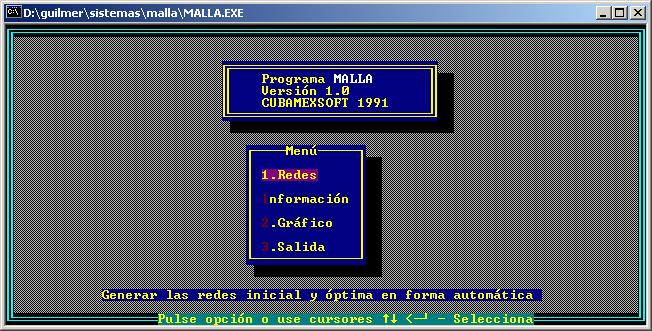



Our experience, in the generation of grids, dates from end of the 80 where we worked again with the group of professor Stanly Steinberg of the University of New Mexico in Albuquerque. Since the beginning of the decade of the 90, we have worked by our account as it is possible to be seen in the bibliography of this document and in addition they have been written around 10 graduate student thesis, masters and doctorate and several versions of a software package UNAMalla for the numerical generation of grid in irregular regions have been developed.
UNAMalla System is the result of an enormous effort of a work group of professors of the Faculty of Sciences (UNAM), of the Institute of Cybernetics and Physics of Cuba, of the Faculty of Physical-Mathematics Sciences of the University of San Nicolás de Hidalgo Michoacán, the Faculty of Sciences of the Autonomous University of Coahuila, when constructing programs or modules that carry out specific tasks.
Next a review of the evolution of the system throughout the last years is described.



GRID
The origin of UNAMalla System goes back to the year of 1989 when GRID program was designed.This it was constructed in the city of Havana where they approached the problem of the numerical generation of grid to solver a little deep water problem on the bay of Havana.
Contributions
Analyzing carefully to attack the discrete problem by Castillo (Castillo 1986) they considered grids like a collection of triangles and not of quadrilaterals. They proposed the problem to minimize the sum of square of the area of the triangles with direction to generate convex grid. The main contribution of this program was to verify be means of the computer that the result obtained by the area functional of Barrera-Pérez are superiors to the area functional of Castillo. It initial grid considered by the system is generated by linear interpolation between boundary. Since the involved problem of optimization is of large scale, the numerical generation of grids to be a very attractive problem, since it allows to analyze the existing methods of optimization and raises the search of an efficient algorithm for its resolution.
Technical details and platform of programming
With this system three different methods were experienced from optimization of laege scale: Conjugated gradient of Fletcher-Reeves (1964), Limited Memory of Nocedal (1980) and Newton Truncated with search in the line (Dembo 1983). The results obtained with each of them were observed. The program was written in programming language FORTRAN 77, being written in programming language C the main program and having to the software of graphic like independent program, being written in QUICKBASIC, all this of course, for PC DOS.



MALLA 1.0
The following year and through an agreement of collaboration between the Academy of Sciences of Cuba and the Faculty of Sciences (UNAM), sponsored by the CONACyT in Mexico the version of the MALLA system 1.0 was developed where the interaction of the system with the user is improved.
Contributions
The input files of the contour of a polygonal region are defined, as well as the possibility of working regions with holes. Similarly the file of grids is defined obtaining a mechanism of entrance and exit of data of the system, with a format of direct use for the user.
 Main menu of the MALLA system v.1.0
Main menu of the MALLA system v.1.0
In the MALLA system 1.0 eliminates the use of the functional of Castillo and they only consider area functional of Barrera-Pérez and the Length functional. Different types from topologies of regions of test are incorporated like triangles and trapezes on which they are experienced grids.
Technical details and platform of programming
This system integrate the modules of initial generation of grid and optimization, this way it is established the modality of automatic generation of grids. The enviroment in which the modules interact was written in programming language PASCAL and the software of graphics of grids in programming language C making use of the graphical library of Microsoft.



SEGRED
In 1990, Rina Ojeda in its Masters theses (Ojeda1991) continues these ideas and constructs the SEGRED system that allows to give a treatment to the boundary of the contour of the region. This treatment consists of generating the points on the boundary that will remain fixed. It obtains it this to using linear interpolation, parametric cubical interpolation or, through smoothing data by parametric cubical splines. This way it allows to control and to smooth out the data of the contour of a polygonal region later to construct grid.
Contributions
Making use of these tools it is constituted the automatic modality of treatment of the contour of the region in subboundary by means of an algorithm that involves the length of the contour and the admissibility of the polygonal region. It grid initial is obtained when considering that one that by interpolation between opposite boundary obtains the smaller number of nonconvex cells. Another contribution of this thesis is to extend the Length functional like an average sum between functional that measures the tension of the vertical lines and one that measures the tension of the horizontals; this way and by means of an suitable election of the weight lines are tightened more than the other. In this work is possible to combine so much the area functional of Barrera-Pérez with this Length functional.
Technical details and platform of programming
The programs continue being written in programming language FORTRAN 77 and the graphical visualization integrate like an option of the main menu what allows to observe grid as much at the end of the process of initial generation like at the end of the optimization. The integration of the modules is obtained with a program in PASCAL. All this in platform for PC DOS.







